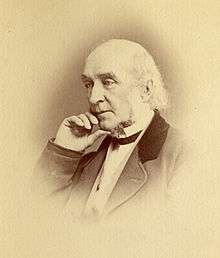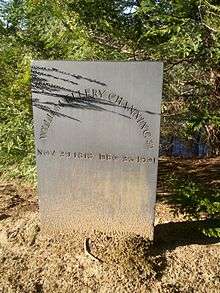William Ellery Channing (poet)
| William Ellery Channing | |
|---|---|
 William Ellery Channing, 1817–1901 | |
| Born |
November 29, 1818 Boston, Massachusetts, United States |
| Died |
December 23, 1901 (aged 83) Concord, Massachusetts, United States |
| Resting place | Sleepy Hollow Cemetery, Concord |
| Occupation | Poet |
| Spouse | Ellen K. Fuller Channing |
| Children | Margaret Fuller Channing (1844–1932; m. Thatcher Loring); Caroline Sturgis Channing (1846–1917; m. Follen Cabot); Walter Channing (1849–1921; m. Anna Morse); Giovanni Eugene Channing (b. 1853; m. Florence Thompson); Edward Perkins Channing (1856–1931; m. Alice Thatcher) |
William Ellery Channing (November 29, 1818 – December 23, 1901) was an American Transcendentalist poet, nephew of the Unitarian preacher Dr. William Ellery Channing. (His namesake uncle was usually known as "Dr. Channing", while the nephew was commonly called "Ellery Channing", in print.) The younger Ellery Channing was thought brilliant but undisciplined by many of his contemporaries. Amos Bronson Alcott famously said of him in 1871, "Whim, thy name is Channing." Nevertheless, the Transcendentalists thought his poetry among the best of their group's literary products.
Life and work
Channing was born in Boston, Massachusetts to Dr. Walter Channing, a physician and Harvard Medical School professor. He attended Boston Latin School and later the Round Hill School in Northampton, Massachusetts, then entered Harvard University in 1834, but did not graduate. In 1839 he lived for some months in Woodstock, Illinois in a log hut that he built; in 1840 he moved to Cincinnati. In the fall of 1842 he married Ellen Fuller, the younger sister of transcendentalist Margaret Fuller[1] and they began their married life in Concord, Massachusetts where they lived a half-mile north of The Old Manse as Nathaniel Hawthorne's neighbor.
Channing wrote to Thoreau in a letter: “I see nothing for you on this earth but that field which I once christened ‘Briars’; go out upon that, build yourself a hut, and there begin the grand process of devouring yourself alive. I see no alternative, no other hope for you.”[2] Thoreau adopted this advice, and shortly after built his famous dwelling beside Walden Pond. Some speculation identifies Channing as the “Poet” of Thoreau's Walden; the two were frequent walking companions.
In 1843 he moved to a hill-top in Concord, some distance from the village, and published his first volume of poems, reprinting several from The Dial. Thoreau called his literary style “sublimo-slipshod”. The printing of a compilation of these poems was subsidized by Samuel Gray Ward.[3]
In 1844–1845, Channing separated from his family and restarted his wandering, unanchored life. He first spent some months in New York City as a writer for the Tribune, after which he made a journey to Europe for several months. In 1846 he returned to Concord and lived alone on the main street, opposite the house occupied by the Thoreau family and then by Alcott. During much of this time he had no fixed occupation, though for a while, in 1855–1856, he was one of the editors of the New Bedford Mercury. After enumerating his various wanderings, places of residence, and rare intervals of employment, his housemate Franklin Benjamin Sanborn wrote of him:
| “ | In all these wanderings and residences his artist eye was constantly seeking out the finest landscapes, and his sauntering habit was to take his friends and introduce them to scenery they could hardly have found for themselves. He showed Thoreau the loveliest recesses of the Concord woods, and of the two rivers that came slowly through them; he preceded Thoreau at Yarmouth and Truro and the Highland shore of Cape Cod; and he even taught Emerson the intimate charm of regions in Concord and Sudbury which he, the older resident and unwearied walker, had never beheld. ... In mountain-climbing and in summer visits to the wilder parts of New England he preceded Thoreau, being more at leisure in his youth, and less bound by those strict habits of study which were native to Thoreau all his life. | ” |
In 1873, Channing was the first biographer of Thoreau, publishing Thoreau, the Poet-Naturalist.[4]
When visiting the Emersons in 1876, the young poet Emma Lazarus met Channing and accompanied him on a tour of some of the places Thoreau had loved, stating in her journal in regard to the friendship between Thoreau and Channing that
| “ | I do not know whether I was most touched by the thought of the unique, lofty character that had instilled this depth and fervor of friendship, or by the pathetic constancy and pure affection of the poor, desolate old man before me, who tried to conceal his tenderness and sense of irremediable loss by a show of gruffness and philosophy. He never speaks of Thoreau’s death, but always “Thoreau’s loss”, or “when I lost Mr. Thoreau”, or “when Mr. Thoreau went away from Concord”; nor would he confess that he missed him, for there was not a day, an hour, a moment, when he did not feel that his friend was still with him and had never left him. And yet a day or two after, when I sat with him in the sunlit wood, looking at the gorgeous blue and silver summer sky, he turned to me and said: “Just half the world died for me when I lost Mr. Thoreau. None of it looks the same as when I looked at it with him.”[5] | ” |
Channing gave Henry Thoreau’s compass to Emma Lazarus.[5]
Death

Channing died 23 December 1901 in Concord, at the home of Franklin Benjamin Sanborn, where he had spent the final ten years of his life. He is buried at Sleepy Hollow Cemetery, Concord on Authors’ Ridge directly facing his longtime friend Thoreau. Frank Sanborn paid for Channing’s burial plot.[6]
| “ | ... as age came on and his chosen companions died, he withheld his steps from mount and stream and sea; would not sail his own Concord river, nor thread the woodpaths he once knew as well as the citizen knows his daily street; and died tranquilly at last, within sight of the hills and meadows he had loved to ramble across with Emerson, Hawthorne, or Thoreau, beside whose buried dust his own ashes will rest in the village cemetery.[7] | ” |
In a 19 July 1902, Springfield Republican article, Frank Sanborn states,
| “ | This week the Channing lot in Sleepy Hollow cemetery received the ashes of the poet Ellery Channing, whose remains were cremated, at his request, last January, but not committed to earth till July 15. The only service was the reading above the grave of a Greek epitaph ... The stanza written by Channing for such an occasion half a century ago was also read, with a slight change, adapting it to the stately pine trees that surround his burial place, exactly opposite the grave of his friend Hawthorne:
|
” |
In a later Republican column, Sanborn informs:
| “ | I have lately come upon the Greek Iambics which I buried with the ashes of Channing in Sleepy Hollow cemetery; and I copy them here in English type, that they may not be wholly lost:
|
” |
Criticism
Critic Edgar Allan Poe was particularly harsh in reviewing Channing's poetry in a series of articles titled "Our Amateur Poets" published in Graham's Magazine in 1843. He wrote, "It may be said in his favor that nobody ever heard of him. Like an honest woman, he has always succeeded in keeping himself from being made the subject of gossip".[10][lower-alpha 1] A critic for the Daily Forum in Philadelphia agreed with Poe, though he was surprised Poe bothered reviewing Channing at all. He wrote:
Mr. Poe, the most hyper-critical writer of this meridian, cuts the poetry of William Ellery Channing Junior, if not into inches, at least into feet. Mr. C’s poetry is very trashy, and we should as soon expect to hear Bryant writing sonnets on a lollypop as to see Mr. Poe gravely attempt to criticize the volume.[11]
Nathaniel Hawthorne metaphorically appraised Channing’s oeuvre as of particularly high quality, if uneven, in the short story "Earth’s Holocaust".[12]
Notes
- ↑ In this article, Poe mistakes W. Ellery Channing to be the son of, rather than nephew of William E. Channing and voices his views as “we” (the Society in Baltimore) rather than “I”.Poe, Edgar Allan. "William Ellery Channing".
References
- ↑ Channing, W. Ellery. Poems of Sixty-Five Years. introduction by Sanborn, F.B., 1902-02-01, p. xxii – via Google Books.
- ↑ Channing, W. Ellery. William Ellery Channing Letters, 1836-1845.
- ↑ Smith, Harmon (1999). My Friend, My Friend: The story of Thoreau's relationship with Emerson. University of Massachusetts Press. p. 85. ISBN 1-55849-186-4.
- ↑ Channing, William Ellery (1873). Thoreau, the Poet-Naturalist.
- 1 2 McGill, Frederick T. Jr. (1967). Channing of Concord: A Life of William Ellery Channing II. New Brunswick: Rutgers University Press. p. 169.
- ↑ Sanborn, Frank B. (1981). Cameron, Kenneth Walter, ed. Ungathered Poems and Transcendental Papers. Hartford, CT: Transcendental Books. p. 215.
- ↑ Sanborn, Frank B. (March 1902). "Ellery Channing in New Hampshire". The Granite Monthly. Vol. XXXII no. 3.
- ↑ Sanborn, Frank B. (19 July 1902). "[newspaper column by F.B. Sanborn]". The Springfield Republican. p. 11, cols. 1–3.
- ↑ Sanborn, Frank B. (20 August 1913). "[newspaper column by F.B. Sanborn]". The Springfield Republican. p. 15, cols. 1–2.
- ↑ Sova, Dawn B. (2001). Edgar Allan Poe: A to Z. New York, NY: Checkmark Books. p. 178. ISBN 0-8160-4161-X.
- ↑ Thomas, Dwight; Jackson, David K. (1987). The Poe Log: A documentary life of Edgar Allan Poe 1809–1849. New York, NY: G.K. Hall & Co. p. 432. ISBN 0-7838-1401-1.
- ↑ Cowley, Malcolm, ed. (1985). The Portable Hawthorne (Revised and expanded ed.). New York: Viking Press. p. 634. ISBN 0517478579.
External links
| Wikiquote has quotations related to: William Ellery Channing (poet) |
| Wikimedia Commons has media related to Ellery Channing. |
- Manuscript Collection with a brief Channing biography from the Concord Free Public Libraries
- Ellery Channing Remembers Henry Thoreau